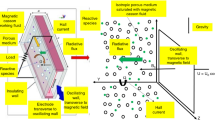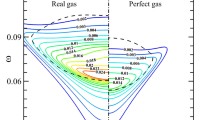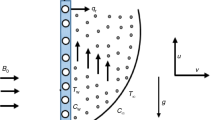Abstract
The paper investigates the effect of uniform heat flux Model A on Darcy-Rayleigh convection with a free surface on the top. The assumption of Model A as thermal boundary conditions is used at the lower surface, while the upper one is only fixed to isothermal conditions. Both approaches of energy equations have been taken into consideration to account for the local thermal non-equilibrium. Linear stability analysis has been performed in the condition where the perturbation terms are evaluated in the form of plane waves. Otherwise, the eigenvalue problem is either dealt with the analytical solution by a dispersion relation or numerically by employing the Range–Kutta solver with the shooting method. According to the results, the transition of the critical values from isothermal to isoflux boundary conditions may emerge in one of the local thermal non-equilibrium assumptions. On the other hand, infinite values may appear in the critical Rayleigh number at the local thermal equilibrium regime. Overall, the thermal instability becomes extremely dominant when the configuration approximates the model of gas saturated with metal foam which is one of the cases of the local thermal non-equilibrium.






Similar content being viewed by others
References
Horton CW, Rogers FT. Convection currents in a porous medium. J Appl Phys. 1945;16:367–70.
Koch T, Weishaupt K, Muller J, Weigand B, Helmig R. A (dual) network model for heat transfer in porous media. Transp Porous Media. 2021;140:107–41.
AL-Sumaily GF, Al Ezzi A, Dhahad HA, Thompson MC, Yusaf T. Legitimacy of the local thermal equilibrium hypothesis in porous media: a comprehensive review. J Energie. 2021;14:2–47.
Nield D. A and Bejan A. 5th ed New York: A Convection in Porous Media. Springer. 2017.
Haji-Sheikh A, Minkowycs WJ. Emerging Topics In Heat and Mass Transfer in Porous Meida. vol 22. Springer, 2008.
Parhizi M, Torabi M, Jain A. Local thermal non-equilibrium (lte) model for developed flow in porous media with spatially-varying biot number. Int J Heat Mass Transf. 2021;164:1–9.
Kambiz V, Kun Y. A note on local thermal non-equilibrium in porous media and heat flux bifurcation phenomenon in porous media. Transp Porous Media. 2013;96(1):169–72.
Barletta A. Thermal instability in a horizontal porous channel with horizontal through flow and symmetric wall heat fluxes. Transp Porous Media. 2011;92:419–37.
Barletta A, Rees DAS. Unstable mixed convection flow in horizontal porous channel with uniform wall heat flux. Transp Porous Media. 2019;129:385–402.
Barletta A, Celli M, Kuznetsov AV. Convective instability of the darcy flow in a horizontal layer fluxes and local thermal nonequilibrium. J Heat Transf. 2014;136:1–12.
Brandao PV, Celli M, Barletta A. Rayleigh-bénard instability of an ellis fluid saturated porous channel with an isoflux boundary. Fluids. 2021;450:2–11.
Celli M, Barletta A, Brandao PV. Rayleigh-bénard instability of an ellis fluid saturating a porous medium. Transp Porous Media. 2021;138:679–92.
Barman D. Effect of local thermal nonequilibrium on the stability of the flow in a vertical channel filled with nanofluid saturated porous medium. J Heat Transf. 2021;144:014501–7.
Hadi Ghasemi M, Hoseinzadah S, Memon S. Adual-phase-lag (dpl) transient non-fourier heat transfer analysis of functional graded cylindrical material under axial heat flux. Int Commun Heat Mass Transf. 2022;131:121–30.
Xiao-Long O, Pei-Xue J, Rui-Na X. Thermal boundary conditions of local thermal non-equilibrium model for convection heat transfer in porous media. Int J Heat Mass Transf. 2013;60:31–40.
Nield DA. A note on local thermal non-equilibrium in porous media near boundaries and interfaces. Transp Porous Media. 2012;95(3):581–4.
Mahmoudi Y, Karimi N. Numerical investigation of heat transfer enhancement in apipe partially filled with a porous material under local thermal non-equilibrium condition. J Heat Mass Transf. 2014;68:161–73.
Mahmoudi Y, Karimi N, Mazaheri K. Analytical investigation of heat transfer enhancement in a channel partially filled with a porous under local thermal non-equilibrium condition:effects of different thermal boundary conditions at the porous-fluid interface. J Heat Mass Transf. 2014;70:875–91.
Banu N, Rees DAS. Onset of Darcy-Bénard convection using a thermal nonequilibrium model. Int J Heat Mass Transf. 2002;45:2221–8.
Funding
This research received no specific grant from any funding agency in the public, commercial, or not-for-profit sectors.
Author information
Authors and Affiliations
Corresponding author
Ethics declarations
Conflict of interest
The author declares that there is no conflict of interest.
Additional information
Publisher's Note
Springer Nature remains neutral with regard to jurisdictional claims in published maps and institutional affiliations.
Appendix
Appendix
A: The principle of exchange of stabilities: the limiting case of \(H\rightarrow \infty\)
The principle of exchange of stabilities deals with the case of LTE model whose governing equations are defined as
The boundary conditions related to LTE model are
Using the boundary conditions Eqs. (37) in the integration by part of Eqs. (36) after multiplying them by their complex conjugated quantities \(\bar{\hat{\psi }}\) and \(\bar{\theta }_\mathrm{{m}}\) gives rise to
We divide Eq. (38a) by the parameter \(-\dfrac{\gamma }{1+\gamma }{R_\gamma }\), and then, we summed up with Eq. (38b) to have
The imaginary part of Eq. (39) is equal to zero only if the condition of Eq. (40) is satisfied,
The two dimensionless parameters \(\lambda\) and \(\gamma\) are defined as positive and trivial solutions. The assumption of \(\theta _\mathrm{{m}}=0\) is not acceptable with what we are dealing with. Therefore, the case of \(\omega _\mathrm{{R}}=0\) is valid in Eq. (40), as consequence, the principle of exchange of instabilities is fulfilled for a special case of \(H\rightarrow \infty\) .
Rights and permissions
Springer Nature or its licensor holds exclusive rights to this article under a publishing agreement with the author(s) or other rightsholder(s); author self-archiving of the accepted manuscript version of this article is solely governed by the terms of such publishing agreement and applicable law.
About this article
Cite this article
Lagziri, H. The investigation of Darcy-Rayleigh convection with uniform heat flux Model A. J Therm Anal Calorim 147, 13585–13595 (2022). https://doi.org/10.1007/s10973-022-11541-y
Received:
Accepted:
Published:
Issue Date:
DOI: https://doi.org/10.1007/s10973-022-11541-y




